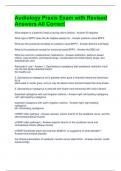Audiology Praxis Exam with Revised
Answers All Correct
What degree is a patient's head at during caloric testing - Answer-30 degrees
What type of BPPV does the dix hallpike assess for - Answer-posterior canal BPPV
What are the positional remedies for posterior canal BPPV - Answer-Semont and Epley
What is the positional remedy for horizontal canal BPPV - Answer-the BBQ roll
What are common vestibulotoxic medications - Answer-antibiotics, platinum-based
chemo, loop diuretics, antimalarial drugs, nonsteroidal anti-inflammatory drugs, and
acetylsalicylic acid
Alexander's Law - Answer-1. Spontaneous nystagmus after peripheral vestibular insult
has the fast phase directed toward
the healthy ear.
2. Spontaneous nystagmus (a) is greatest when gaze is directed toward the fast phase,
(b) is
attenuated in center gaze, and (c) may be absent when directed toward the slow phase.
3. Spontaneous nystagmus is reduced with fixation and enhanced with vision-denied.
Expected nystagmus with cool irrigation calorics - Answer-right: left-beating nystagmus
Left: right-beating nystagmus
expected nystagmus with warm irrigation calorics - Answer-right: right-beating
nystagmus
left: left-beating nystagmus
cVEMP reflex pathway - Answer-saccule, inferior branch of the vestibular nerve, and the
sternocleidomastoid muscle
oVEMP reflex pathways - Answer-superior branch of the vestibular nerve and
contralateral inferior oblique muscle
oVEMP thresholds which are less than 85dB HL is suggestive of what disorder? -
Answer-third window disorder
the clinical presentation of vestibular neuritis versus labyrnthitis - Answer-neuritis: vestib
issues/vertigo
,labyrinthitis: vestib and hearing loss/tinnitus
clinical presentation of posterior SCC BPPV - Answer-1 to 10 seconds after a provoking
movement
symptoms < 1 minute
torsional up-beating nystagmus (toward lower ear), changes direction when a patient
sits up
nystagmus and symptoms fatigue with repeated evaluation or repositioning
Upward, rightward torsional nystagmus is caused by BPPV of what canal - Answer-
RIGHT posterior canal
Upward, leftward torsional nystagmus is caused by BPPV of what canal - Answer-LEFT
posterior canal
Downward, rightward torsional nystagmus is caused by BPPV of what canal - Answer-
RIGHT anterior
Apert Syndrome - Answer-genetic disorder that includes craniosynostosis, midline facial
hypoplasia, and syndactyly
sagittal/longitudinal plane - Answer-divides structure into left and right
Frontal/coronal plane - Answer-Divides the structure into front (anterior) and back
(posterior)
Axial/Transverse plane - Answer-Divides the structure into top/bottom
proximal - Answer-Close to the middle of the body/point of attachment
Distal - Answer-Away from the middle of the body/point of attachment
Parts of the peripheral auditory system - Answer-Outer ear, middle ear, inner ear,
auditory nerve
Parts of the central auditory system - Answer-Cochlear nucleus, superior olivary
complex, lateral leminiscus, inferior colliculus, medial geniculate body, auditory cortex,
associated areas
What is the function of the outer ear? - Answer-Facilitate entry (funnel) sound into the
EAC
What type of energy is sound at the level of the outer ear? - Answer-acoustic energy
,Anatomical features of the outer ear - Answer-Pinna, tragua, anti-tragus, concha, helix,
anti-helix, lobe, EAC, triangular fossa, scaphoid fossa
What is the function of the middle ear? - Answer-impedance matcher (transformer)
What type of energy is sound at the level of the middle ear? - Answer-mechanical
energy
Anatomical features of the middle ear - Answer-malleus, incus, stapes, tympanic
membrane (pars flaccida/pars tensa), eustachian tube
What is the function of the inner ear? - Answer-convert mechanical to electrical signal
What type of energy is at the level of the inner ear? - Answer-electrical
Anatomical features of the inner ear - Answer-oval window, round window, basilar
membrane, tectorial membrane, scale tympani, scale media, scala vestibuli, spiral
ganglion, otic capsule
At what dB/frequency is the boost created by the pinna? - Answer-10 dB "boost" at
5,000 Hz
The anatomical convolutions of the outer ear emphasize what frequencies? - Answer-
2000-5000 Hz
At what degree is the pinna attached to the head? - Answer-15-30 degree angle
What is the pinna made of? - Answer-perichondrium and squamous epithelium
Pathology impacting the outer ear will thus impact what range of frequencies? - Answer-
2,000-5,000 Hz
What nerve is the pinna innervated by? - Answer-auriculotemporal (CN V or the
Trigeminal)
What nerve(s) is the concha innervated by? - Answer-facial or CN VII, glossopharyngeal
or CN IX, and the vagus or CN X
Where does the pinna receive blood supply from? - Answer-external carotid artery:
(branch 1) superficial temporal artery and (branch 2) posterior auricular artery
How long does the EAC measure in typically developed children and adults? - Answer-
Adults: 1-inch
Kids: 6-8 mm
, How much dB and at what frequency does the EAC emphasize? - Answer-12 dB
"boost" around 3000 Hz
How does the nature of the EAC vary from adults to children? - Answer-Adults: "S"
shaped, angling downward
Kids: straight and horizontal
What is the osseocartilaginous juncture called within the EAC? - Answer-The isthmus
How much of the EAC is bony versus cartilaginous? How does each part "run" in
comparison to the tragus? - Answer-distal 1/3= cartilaginous (runs anterior/superior from
tragus)
proximal= 2/3 bony (runs posterior/superior from tragus)
What bony portion is the EAC located in within the skull? - Answer-the tympanic portion
of the temporal bone
What are the 4 parts of the temporal bone? - Answer-1.Squamous
2. Mastoid
3. Petrous
4. Tympanic
What dermatological markers are found within the cartilaginous portion of the EAC? -
Answer-Thick squamous epithelium, hair follicles, vasculature, fat, and
sebaceous/ceruminous glands
What is the pH of cerumen and why is this helpful? - Answer-pH- 6/1
This creates a toxic environment for insects, serves slightly as an
antifungal/antibacterial, keeping the EAC lubricated
What surrounds the TM and attaches it to the temporal bone? - Answer-annular
ligament
What are the three layers of the TM? (list laterally to medially) - Answer-epithelial layer -
fibrous layer - mucosal layer
Describe the two portions of the TM. - Answer-Pars Flaccida: superior portion
Pars Tensa: majority of the TM; sits inferior
Where does the TM connect to the malleus? - Answer-it connects via the mannubrium
What are the three methods of impedance matching seen in the middle ear? - Answer-
1. area ratio
2. ossicular lever ratio




